Applications of Electric Heating Technology in Vehicle Exhaust Pollution Control
Abstract
:1. Introduction
2. Applications in Vehicle Emission Control
2.1. Application to Gasoline Engine Vehicles
2.2. Application to Diesel Vehicles
2.3. Application to Motorcycles
2.4. Application to Hybrid Vehicles
3. Structure of Electric Heaters
4. Electric Power Source
5. Conclusions
- The combination of electric heating technology and catalytic aftertreatment devices, such as DOC, SCR, and TWC, can quickly increase the catalyst temperature, greatly reducing pollutant emissions during the cold start stage of the engine or under low-load and low-temperature conditions. Electric heating technology can also achieve stable regeneration of particulate matter filters by increasing temperature.
- Electric heating technology has been widely studied and applied in the field of exhaust aftertreatment for various vehicles powered by internal combustion engines, such as gasoline vehicles, diesel vehicles, motorcycles, and hybrid vehicles.
- Reasonably arranging the positions of electric heaters and aftertreatment devices and developing optimized heating schemes can reduce additional energy consumption while ensuring heating and emission reduction effects, achieving lower fuel consumption than other heating schemes.
- A traditional electric heating power supply is a 12 or 24 V battery in the vehicle. Increasing the power supply voltage can improve the heating effect and reduce electrical energy loss. Exhaust gas waste heat recovery for power generation is also a promising power solution that can greatly reduce fuel consumption losses caused by electric heating.
Author Contributions
Funding
Data Availability Statement
Acknowledgments
Conflicts of Interest
References
- Lelieveld, J.; Evans, J.S.; Fnais, M.; Giannadaki, D.; Pozzer, A. The contribution of outdoor air pollution sources to premature mortality on a global scale. Nature 2015, 525, 367–384. [Google Scholar] [CrossRef]
- Yang, L.E.; Hoffmann, P.; Scheffran, J. Health impacts of smog pollution: The human dimensions of exposure. Lancet Planet. Health 2017, 1, 132–133. [Google Scholar] [CrossRef]
- Li, H.; Huang, W.Q.; Qian, Y.; Klemeš, J.J. Air pollution risk assessment related to fossil fuel-driven vehicles in megacities in China by employing the Bayesian network coupled with the Fault Tree method. J. Clean. Prod. 2023, 383, 135458. [Google Scholar] [CrossRef]
- Xu, H.R.; Chen, Y.J. The impact of air pollution on the stock performance- Evidence from China new energy vehicle industry. Energy Rep. 2022, 8, 315–320. [Google Scholar] [CrossRef]
- Blanco-Rodriguez, D.; Vagnoni, G.; Holderbaum, B. EU6 C-Segment Diesel vehicles, a challenging segment to meet RDE and WLTP requirements. IFAC-PapersOnLine 2016, 49, 649–656. [Google Scholar] [CrossRef]
- Shi, X.R.; Lei, Y.; Xue, W.B.; Liu, X.; Li, S.Y.; Xu, Y.L.; Lv, C.; Wang, S.X.; Wang, J.; Yan, G. Drivers in carbon dioxide, air pollutants emissions and health benefits of China’s clean vehicle fleet 2019–2035. J. Clean. Prod. 2023, 391, 136167. [Google Scholar] [CrossRef]
- Tu, R.; Xu, J.S.; Wang, A.; Zhang, M.Q.; Zhai, Z.Q.; Hatzopoulou, M. Real-world emissions and fuel consumption of gasoline and hybrid light duty vehicles under local and regulatory drive cycles. Sci. Total Environ. 2022, 805, 150407. [Google Scholar] [CrossRef] [PubMed]
- Anderson, A.M.; Bruno, B.A.; Santos, J.; Barry, P.J.; Carroll, M.K. PGM nanoparticle-based alumina aerogels for three-way catalyst applications. Catal. Commun. 2022, 172, 106547. [Google Scholar] [CrossRef]
- Karre, A.V.; Garlapalli, R.K.; Jena, A.; Tripathi, N. State of the art developments in oxidation performance and deactivation of diesel oxidation catalyst (DOC). Catal. Commun. 2023, 179, 106682. [Google Scholar] [CrossRef]
- Rodvanna, S.; Srilomsak, M.; Nuthong, C.; Charoenphanich, C.; Masomtob, M.; Saisirirat, P.; Chollacoop, N.; Hanamura, K.; Karin, P. Physicochemical characteristics of ashes deposited on a wall flow diesel particulate filter of compression ignition engine. Case Stud. Chem. Environ. Eng. 2023, 7, 100316. [Google Scholar] [CrossRef]
- Kumar, M.V.; Babu, A.V.; Reddy, C.R.; Pandian, A.; Bajaj, M.; Zawbaa, H.M.; Kamel, S. Investigation of the combustion of exhaust gas recirculation in diesel engines with a particulate filter and selective catalytic reactor technologies for environmental gas reduction. Case Stud. Therm. Eng. 2022, 40, 102557. [Google Scholar] [CrossRef]
- Eriksson, O.H.L. Modeling and Analytical Solutions for Optimal Heating of Aftertreatment Systems. IFAC PapersOnLine 2019, 52–55, 523–530. [Google Scholar]
- Wang, W.; Zhao, S.Z.; Tang, X.L.; Chen, C.Q.; Yi, H.H. Electrothermal catalysis for heterogeneous reaction: Mechanisms and design strategies. Chem. Eng. J. 2023, 455, 140272. [Google Scholar] [CrossRef]
- Zhu, Q.L.; Li, H.; Wang, Y.; Zhou, Y.; Zhu, A.M.; Chen, X.; Li, X.N.; Chen, Y.F.; Lu, H.F. Novel metallic electrically heated monolithic catalysts towards VOC combustion. Catal. Sci. Technol. 2019, 9, 6638–6646. [Google Scholar] [CrossRef]
- Li, J.J.; Lu, X.F.; Wu, F.; Qin, S.L.; You, Z.X. Metallic-substrate-supported manganese oxide as Joule-heat-ignition catalytic reactor for removal of carbon monoxide and toluene in air. Chem. Eng. J. 2017, 328, 1058–1065. [Google Scholar] [CrossRef]
- Yusufa, A.A.; Inambao, F.L. Effect of cold start emissions from gasoline-fueled engines of light-duty vehicles at low and high ambient temperatures: Recent trends. Case Stud. Therm. Eng. 2019, 14, 100417. [Google Scholar] [CrossRef]
- Gao, J.B.; Tian, G.H.; Sorniotti, A.; Karci, A.E.; Palo, R.D. Review of thermal management of catalytic converters to decrease engine emissions during cold start and warm up. Appl. Therm. Eng. 2019, 147, 177–187. [Google Scholar] [CrossRef]
- Fernández-García, M.; Iglesias-Juez, A.; Martínez-Arias, A.; Hungría, A.B.; Anderson, J.A.; Conesa, J.C.; Soria, J. Role of the state of the metal component on the light-off performance of Pd-based three-way catalysts. J. Catal. 2004, 221, 594–600. [Google Scholar] [CrossRef]
- Küper, P.F.; Maus, W.; Swars, H.; Brück, R.; Kaiser, F.W. Ultra-Low Power Electrically-Heated Catalyst System; SAE Technical Paper 940465; SAE Publication: Warrendale, PA, USA, 1994. [Google Scholar]
- Brunson, G.; Kubsh, J.E.; Whittenberger, W.A. Combining Heated and Unheated Core Functions for Improved Cold Start Emissions Performance; SAE Technical Paper 932722; SAE Publication: Warrendale, PA, USA, 1993. [Google Scholar]
- Tyagi, R.K.; Ranjan, R. Effect of heating the catalytic converter on emission characteristic of gasoline automotive vehicles. Int. J. Ambient Energy 2015, 36, 235–241. [Google Scholar] [CrossRef]
- Charles, X.; Chakraborthy, P.S.; Nallusamy, K.S. Use of Electrically Heated Metal Catalytic Converter in Cold Starting to Reduce Automotive Emissions. Sci. Technol. Arts Res. J. 2013, 2, 147–152. [Google Scholar] [CrossRef]
- Newkirk, M.S.; Smith, L.R.; Payne, M.E.; Segal, J.S. Reactivity and Exhaust Emissions from an EHC-Equipped LPG Conversion Vehicle Operating on Butane/Propane Fuel Blends; SAE Technical Paper 961991; SAE Publication: Warrendale, PA, USA, 1996. [Google Scholar]
- Coppage, G.N.; Bell, S.R. Use of an Electrically Heated Catalyst to Reduce Cold-Start Emissions in a Bi-Fuel Spark Ignited Engine. J. Eng. Gas Turbines Power 2001, 123, 125–131. [Google Scholar] [CrossRef]
- Presti, M.; Pace, L.; Poggio, L.; Rossi, V. Cold Start Thermal Management with Electrically Heated Catalyst: A Way to Lower Fuel Consumption; SAE Technical Paper 2013-24-0158; SAE Publication: Warrendale, PA, USA, 2013. [Google Scholar]
- Liu, M.; Guo, D.D.; Cao, H.L.; Chen, T.; Lin, H.; Zhan, R.J. Influence of electrically-heated metallic substrate catalyst on emission performance of gasoline engine during cold start. Veh. Engine 2021, 2021, 45–49. [Google Scholar]
- Heimrich, M.J.; Albu, S.; Osborn, J. Electrically-Heated Catalyst System Conversions on Two Current-Technology Vehicles; SAE Technical Paper 910612; SAE Publication: Warrendale, PA, USA, 1991. [Google Scholar]
- Bhaskar, K.; Nagarajan, G.; Sampath, S. Experimental Investigation on Cold Start Emissions Using Electrically Heated Catalyst in A Spark Ignition Engine. Int. J. Automot. Mech. Eng. 2010, 2, 105–118. [Google Scholar] [CrossRef]
- Saliba, G.; Saleh, R.; Zhao, Y.L.; Presto, A.A.; Lambe, A.T.; Frodin, B.; Sardar, S.; Maldonado, H.; Maddox, C.; May, A.A.; et al. Comparison of Gasoline Direct-Injection (GDI) and Port Fuel Injection (PFI) Vehicle Emissions- Emission Certification Standards, Cold-Start, Secondary Organic Aerosol Formation Potential, and Potential Climate Impacts. Environ. Sci. Technol. 2017, 51, 6542–6552. [Google Scholar] [CrossRef] [PubMed]
- Sgro, L.A.; Sementa, P.; Vaglieco, B.M.; Rusciano, G.; D’Anna, A.; Minutolo, P. Investigating the origin of nuclei particles in GDI engine exhausts. Combust. Flame 2012, 159, 1687–1692. [Google Scholar] [CrossRef]
- Xie, Y.; Zuo, Q.S.; Wang, M.X.; Wei, K.X.; Zhang, B.; Chen, W.; Tang, Y.Y.; Wang, Z.Q.; Zhu, G.H. Effects analysis on soot combustion performance enhancement of an improved catalytic gasoline particulate filter regeneration system with electric heating. Fuel 2021, 290, 119975. [Google Scholar] [CrossRef]
- Kessels, J.T.B.A.; Foster, D.L.; Bleuanus, W.A.J. Fuel Penalty Comparison for (electrically) heated catalyst. Oil Gas Sci. Technol. 2010, 65, 47–54. [Google Scholar] [CrossRef]
- Pace, L.; Presti, M. An Alternative Way to Reduce Fuel Consumption During Cold Start: The Electrically Heated Catalyst; SAE Technical Paper 2011-24-0178; SAE Publication: Warrendale, PA, USA, 1991. [Google Scholar]
- Velmurugan, D.V.; McKelvey, T.; Olsson, J. A simulation framework for cold-start evaluation of a gasoline engine equipped with an electrically heated three-way catalyst. IFAC PapersOnLine 2021, 54, 526–533. [Google Scholar] [CrossRef]
- Diestelmeier, J. Meeting Emissions Limits while Improving Efficiency. MTZ Worldw. 2020, 81, 60–66. [Google Scholar] [CrossRef]
- Hamedi, M.R.; Doustdar, O.; Tsolakis, A.; Hartland, J. Energy-efficient heating strategies of diesel oxidation catalyst for low emissions vehicles. Energy 2021, 230, 120819. [Google Scholar] [CrossRef]
- Duan, L.S.; Tan, P.Q.; Liu, J.T.; Liu, Y.; Chen, Y.J.; Lou, D.M.; Hu, Z.Y. Emission characteristics of a diesel engine with an electrically heated catalyst under cold start conditions. J. Clean. Prod. 2022, 380, 134965. [Google Scholar] [CrossRef]
- Culbertson, D.; Khair, M.; Zhang, S.H.; Tan, J.L.; Spooler, J. The Study of Exhaust Heating to Improve SCR Cold Start Performance; SAE Technical Paper 2015-01-1027; SAE Publication: Warrendale, PA, USA, 2015. [Google Scholar]
- Culbertson, D.; Khair, M.; Zha, Y.H.; Diestelmeier, J. Exhaust Heating System Performance for Boosting SCR Low Temperature Efficiency; SAE Technical Paper 2018-01-1428; SAE Publication: Warrendale, PA, USA, 2018. [Google Scholar]
- Moon, S.; Park, S.; Son, J.; Oh, K.; Jang, S. Simplified Modeling and Analysis of Surface Temperature Distribution in Electrically Heated Catalyst for Diesel Urea-SCR Systems. Energies 2022, 15, 6406. [Google Scholar] [CrossRef]
- Pfahl, U.; Schatz, A.; Konieczny, R. Advanced Exhaust Gas Thermal Management for Lowest Tailpipe Emissions Combining Low Emission Engine and Electrically Heated Catalyst; SAE Technical Paper 2012-01-1090; SAE Publication: Warrendale, PA, USA, 2012. [Google Scholar]
- Menne, C.; Schrewe, K.; Maurer, B.; Schlencker, J. Modular HJS heavy-duty exhaust gas aftertreatment system with independent thermal management for high NOx conversion especially in urban operation. In Internationaler Motorenkongress; Springer Vieweg: Wiesbaden, Germany, 2019; pp. 221–234. [Google Scholar]
- Ehrly, M.; Ghetti, S.; Kossioris, T.; Schaub, J. Nearly-Zero Emissions Diesel Engines as a Solution for the Urban Work Machine. ATZ Heavy Duty Worldw. 2022, 15, 40–47. [Google Scholar] [CrossRef]
- Naseri, M.; Aydin, C.; Mulla, S.; Conway, R.; Chatterjee, S. Development of Emission Control Systems to Enable High NO Conversion on Heavy Duty Diesel Engines; SAE Technical Paper 2015-01-0992; SAE Publication: Warrendale, PA, USA, 2015. [Google Scholar]
- Feng, X.Y.; Ge, Y.S.; Tan, J.W.; Li, J.Q.; Zhang, Y.; Yu, C.L. Effects of Electrically Heated Catalyst on the Low Temperature Performance of Vanadium-Based SCR Catalyst on Diesel Engine; SAE Technical Paper 2014-01-1527; SAE Publication: Warrendale, PA, USA, 2014. [Google Scholar]
- Kim, C.H.; Paratore, M.; Gonze, E.; Solbrig, C.; Smith, S. Electrically Heated Catalysts for Cold-Start Emissions in Diesel Aftertreatment; SAE Technical Paper 2012-01-1092; SAE Publication: Warrendale, PA, USA, 2012. [Google Scholar]
- Holz, O.; Presti, M. Thermal Management for Low NOx Applications in Heavy Duty Vehicles. ATZ Heavy Duty Worldw. 2021, 14, 36–39. [Google Scholar] [CrossRef]
- Menne, C.; Schrewe, K.; Maurer, B.; Steigert, S. Highly Efficient Emissions Aftertreatment Systems for Low-emission Combustion Engines. ATZ Heavy Duty Worldw. 2020, 13, 46–51. [Google Scholar] [CrossRef]
- Hadl, K.; Raser, B.; Sacher, T.; Graf, G. Solutions for Lowest NOx and CO2 Emissions on Heavy Duty Engines. MTZ Worldw. 2021, 82, 16–23. [Google Scholar] [CrossRef]
- Avolio, G.; Rösel, G.; Maiwald, O. Super Clean Electrified Diesel. MTZ Worldw. 2017, 78, 50–57. [Google Scholar] [CrossRef]
- Masoudi, M.; Poliakov, N.; Noorfeshan, S.; Hensel, J.; Tegeler, E. A Heated AdBlue-DEF Mixer for High Efficiency NOx Reduction in Low Temperature Drive Cycles, RDE and City Driving. Top. Catal. 2023, 66, 771–776. [Google Scholar] [CrossRef]
- Zobel, T.; Schürch, C.; Boulouchos, K.; Onder, C. Reduction of Cold-Start Emissions for a Micro Combined Heat and Power Plant. Energies 2020, 13, 1862. [Google Scholar] [CrossRef]
- Matheaus, A.; Neely, G.; Sharp, C.; Hopkins, J.; McCarthy, J. Fast Diesel Aftertreatment Heat-Up Using CDA and an Electrical Heater; SAE Technical Paper 2021-01-0211; SAE Publication: Warrendale, PA, USA, 2021. [Google Scholar]
- Ciaravino, C.; Ferreri, P.; Pozzi, C.; Previtero, G.; Sapio, F.; Romagnolo, J. Ultra-low NOx diesel aftertreatment: An assessment by simulation. Transp. Eng. 2022, 9, 100124. [Google Scholar] [CrossRef]
- Guan, B.; Zhan, R.; Lin, H.; Huang, Z. Review of the state-of-the-art of exhaust particulate filter technology in internal combustion engines. J. Environ. Manag. 2015, 154, 225–258. [Google Scholar] [CrossRef]
- Kong, Y.; Kozakiewicz, T.; Johnson, R.; Huffmeyer, C.; Huckaby, J.; Abel, J.; Baurley, J.; Duffield, K. Active DPF Regeneration for 2007 Diesel Engines; SAE Technical Paper 2005-01-3509; SAE Publication: Warrendale, PA, USA, 2005. [Google Scholar]
- Zhang, D.M.; Li, S.M.; Li, K.; Bao, X.F.; Wang, M.; Qin, H.Y. Study on DOC Auxiliary DPF Regeneration Method. J. Mech. Eng. 2010, 46, 107–110. [Google Scholar] [CrossRef]
- Tang, T.; Cao, D.X.; Zhang, J.; Zhao, Y.G.; Shuai, S.J. Experimental Study of Catalyzed Diesel Particulate Filter with Exhaust Fuel Injection System for Heavy-Duty Diesel Engines; SAE Technical Paper 2014-01-1496; SAE Publication: Warrendale, PA, USA, 2014. [Google Scholar]
- Fang, J.; Meng, Z.W.; Li, J.S.; Du, Y.H.; Qin, Y.; Jiang, Y.; Bai, W.L.; Chase, G.G. The effect of operating parameters on regeneration characteristics and particulate emission characteristics of diesel particulate filters. Appl. Therm. Eng. 2019, 148, 860–867. [Google Scholar] [CrossRef]
- Meng, Z.W.; Li, J.S.; Fang, J.; Tan, J.; Qin, Y.; Jiang, Y.; Qin, Z.H.; Bai, W.L.; Liang, K. Experimental study on regeneration performance and particle emission characteristics of DPF with different inlet transition sections lengths. Fuel 2020, 262, 116487. [Google Scholar] [CrossRef]
- Meng, Z.W.; Zeng, B.S.; Tan, J.; Chen, Z.; Ou, J. Study of gas and particulate emission characteristics during the fast regeneration period of DPF. Fuel 2022, 317, 123353. [Google Scholar] [CrossRef]
- Zhong, C.; Gong, J.K.; Liu, W.Q.; Liu, G.L. Low temperature, medium temperature and high temperature performance of the continuous regenerative diesel particulate filter assisted by electric regeneration. Chem. Eng. Sci. 2019, 207, 980–992. [Google Scholar] [CrossRef]
- Horng, R.F.; Chou, H.M.; Hsu, T.C. Effects of heating energy and heating position on the conversion characteristics of the catalyst of a four-stroke motorcycle engine in cold start conditions. Energy Convers. Manag. 2004, 45, 2113–2126. [Google Scholar] [CrossRef]
- Horng, R.F.; Chou, H.M. Effect of input energy on the emission of a motorcycle engine with an electrically heated catalyst in cold-start conditions. Appl. Therm. Eng. 2004, 24, 2017–2028. [Google Scholar] [CrossRef]
- Horng, R.F.; Chou, H.M.; Hsu, T.C. Reaction of the electrically-heated catalyst of a four-stroke motorcycle engine under cold-start conditions with additional enrichment of the intake mixture. Proc. Inst. Mech. Eng. Part D J. Automob. Eng. 2003, 217, 1117–1124. [Google Scholar] [CrossRef]
- Mianzarasvand, F.; Shirneshan, A.; Afrand, M. Effect of electrically heated catalytic converter on emission characteristic of a motorcycle engine in cold-start conditions: CFD simulation and kinetic study. Appl. Therm. Eng. 2017, 127, 453–464. [Google Scholar] [CrossRef]
- Khan, S.R.; Zeeshan, M.; Iqbal, S. Thermal management of newly developed non-noble metal-based catalytic converter to reduce cold start emissions of small internal combustion engine. Chem. Eng. Commun. 2018, 205, 680–688. [Google Scholar] [CrossRef]
- Raja, A.S.; Arasu, A.V. Control of cold start hydrocarbon emissions of motor bike engine by gasoline-ethanol blends and intake air heating. J. Mech. Sci. Technol. 2014, 28, 1567–1573. [Google Scholar] [CrossRef]
- Wei, H.B.; Qin, D.T.; Peng, Z.Y.; Chen, S.J. Impact Analysis of Heated Energy in HEV for Three Way Catalyst’s Efficiency, Fuel Consumption and Emission. China Mech. Eng. 2013, 24, 2533–2538. [Google Scholar]
- Deng, T.; Yu, H.Y.; Li, Z.F.; Tan, H.X. PSHEV Cold Start Emission Simulation Based on Electric Heated Catalyst Pre-heating. J. Syst. Simul. 2019, 31, 1150–1157. [Google Scholar]
- Bargman, B.; Jang, S.H.; Kramer, J.; Soliman, I.; Mohamed, A.A.A. Effects of Electrically Preheating Catalysts on Reducing High-Power Cold-Start Emissions; SAE Technical Paper 2021-01-0572; SAE Publication: Warrendale, PA, USA, 2021. [Google Scholar]
- Sivakumar, S.; Shingyouchi, H.; Yan, X.Y.; Okajima, T.; Yamaguchi, K.; Kusaka, J. Effects of Using an Electrically Heated Catalyst on the State of Charge of the Battery Pack for Series Hybrid Electric Vehicles at Cold Start; SAE Technical Paper 2020-01-0444; SAE Publication: Warrendale, PA, USA, 2020. [Google Scholar]
- Canè, S.; Brunelli, L.; Gallian, S.; Perazzo, A.; Brusa, A.; Cavina, N. Performance assessment of a predictive pre-heating strategy for a hybrid electric vehicle equipped with an electrically heated catalyst. Appl. Therm. Eng. 2023, 219, 119341. [Google Scholar] [CrossRef]
- Bissett, E.J.; Oh, S.H. Electrically heated converters for automotive emission control: Determination of the best size regime for the heated element. Chem. Eng. Sci. 1999, 54, 3957–3966. [Google Scholar] [CrossRef]
- Kubsh, J.E.; Brunson, G.W. EHC Design Options and Performance; SAE Technical Paper 960341; SAE Publication: Warrendale, PA, USA, 1996. [Google Scholar]
- Fricke, F.; Steinhuber, T.; Grußmann, E.; Rusche, U. Concept Studies for Electrically Heated Catalysts. MTZ Worldw. 2021, 82, 28–33. [Google Scholar] [CrossRef]
- Hanel, F.J.; Otto, E.; Brück, R.; Nagel, T.; Bergau, N. Practical Experience with the EHC System in the BMW ALPINA B12; SAE Technical Paper 970263; SAE Publication: Warrendale, PA, USA, 1997. [Google Scholar]
- Maus, W.; Brück, R.; Konieczny, R.; Hirth, P. The Future of Exhaust Aftertreatment Design for Electrified DriveTrains. MTZ Worldw. 2012, 73, 18–25. [Google Scholar] [CrossRef]
- Brezny, R.; Westgate, P.J.; Brunson, G.; Hughes, E. Electrical Durability of an EHC; SAE Technical Paper 950406; SAE Publication: Warrendale, PA, USA, 1995. [Google Scholar]
- Brück, R.; Hirth, P.; Hu, B.; Schorn, C. New Catalyst Substrate Innovation for Achieving RDE and SULEV 30 Emission Legislation. MTZ Worldw. 2017, 78, 16–23. [Google Scholar] [CrossRef]
- Socha, L.S.; Thompson, D.F. Electrically Heated Extruded Metal Converters for Low Emission Vehicles; SAE Technical Paper 920093; SAE Publication: Warrendale, PA, USA, 1992. [Google Scholar]
- Tschopp, F.; Nüesch, T.; Wang, M.; Onder, C. Optimal Energy and Emission Management of a Diesel Hybrid Electric Vehicle Equipped with a Selective Catalytic Reduction System; SAE Technical Paper 2015-24-2548; SAE Publication: Warrendale, PA, USA, 2015. [Google Scholar]
- Socha, L.S.; Thompson, D.F.; Weber, P.A. Optimization of Extruded Electrically Heated Catalysts; SAE Technical Paper 940468; SAE Publication: Warrendale, PA, USA, 1992. [Google Scholar]
- Schatz, A.; Knorr, T.; Ellmer, D. Electrically Heated Catalyst for Optimising Emissions in Mild Hybrid Systems. MTZ Worldw. 2015, 76, 58–64. [Google Scholar] [CrossRef]
- Laible, T.; Stefan, P.; Günther, M. Light-off/out Support at Catalyst of Diesel Engine. MTZ Worldw. 2023, 76, 58–64. [Google Scholar] [CrossRef]
- Lindemann, B.; Schrewe, K.; Steigert, S. Electric Heater for Rapid Heating of the Exhaust Gas Aftertreatment System. ATZ Heavy Duty Worldw. 2022, 15, 38–43. [Google Scholar] [CrossRef]
- Sendil velan, S.; Jeyachandran, K.; Bhaskar, K. Experimental Investigation of Emission Control from Spark-Ignition Engine Using Electrically Heated Catalyst; SAE Technical Paper 2001-01-2000; SAE Publication: Warrendale, PA, USA, 2001. [Google Scholar]
- Sendilvelan, S.; Bhaskar, K. Experimental analysis of catalytic converter for reducing environmental pollution from SI engine using electrically initiated and chemically heated catalyst. ARPN J. Eng. Appl. Sci. 2016, 11, 13735–13739. [Google Scholar]
- Li, W.; Du, X.S.; Li, Z.; Tao, Y.Q.; Xue, J.Y.; Chen, Y.R.; Yang, Z.Q.; Ran, J.Y.; Rac, V.; Rakić, V. Electrothermal alloy embedded V2O5-WO3-TiO2 catalyst for NH3-SCR with promising wide operating temperature window. Process Saf. Environ. Prot. 2022, 159, 213–220. [Google Scholar] [CrossRef]
- Aktas, F.; Dinler, N.; Karaaslan, S.; Turker, A.; Yucel, N. Experimental investigation of cold start emission using preheating system on the exhaust line at the idle conditions on a spark ignition engine. Sadhana 2021, 46, 136. [Google Scholar] [CrossRef]
- Konagai, N.; Takeshita, T.; Azuma, N.; Ueno, A. Preparation of Fe−Cr Wires with Dispersed Co3O4 as an Electrically Heated Catalyst for Cold-Start Emissions. Ind. Eng. Chem. Res. 2006, 45, 2967–2972. [Google Scholar] [CrossRef]
- Sun, Z.; Sun, P.; Ji, Q.; Zhao, S.B. Experimental Research on Electrical Heating Regeneration for DPF. Veh. Engine 2014, 2014, 80–83. [Google Scholar]
- Zheng, Q.F.; Guo, J.W. Research on Regeneration Test of Marine Diesel Engine PM Filter With Electric Heating Technology. J. Green Sci. Technol. 2015, 2015, 258–259. [Google Scholar]
- Zuo, Q.S.; Yang, X.M.; Ma, Y.; Zhang, B.; Shen, Z.; Zhai, R.H. Characteristics of NO Conversion rate and Carrier Temperature Distribution in Electrically Heated Multi-carrier Catalytic Converter. J. Cent. South Univ. 2021, 52, 4492–4502. [Google Scholar]
- Cooksona, E.J.; Floyda, D.E.; Shih, A.J. Design, manufacture, and analysis of metal foam electrical resistance heater. International J. Mech. Sci. 2006, 48, 1314–1322. [Google Scholar] [CrossRef]
- Saito, M.; Hoshino, H.; Furuhata, T.; Arai, M. Continuous regeneration of an electrically heated diesel particulate trap: Mechanism of particulate matter trapping and improvement of trapping efficiency. Int. J. Engine Res. 2010, 11, 127–136. [Google Scholar] [CrossRef]
- Arai, M.; Saito, M.; Mitsuyama, Y. Continuous regeneration of an electrically heated diesel particulate trap. Int. J. Engine Res. 2007, 8, 477–486. [Google Scholar] [CrossRef]
- Leahey, N.; Crawford, R.; Douglas, J.; Bauman, J. Induction Heating of Catalytic Converter Systems and its Effect on Diesel Exhaust Emissions during Cold Start; SAE Technical Paper 2018-01-0327; SAE Publication: Warrendale, PA, USA, 2018. [Google Scholar]
- Hampton, L.E.; Buhrmaster, C.L.; Thompson, D.F.; Weiss, D.S. Durability of Advanced Electrically Heated Catalyst Design; SAE Technical Paper 960345; SAE Publication: Warrendale, PA, USA, 1996. [Google Scholar]
- Liu, Y.X.; Canova, M.; Wang, Y.Y. Distributed Energy and Thermal Management of a 48-V Diesel Mild Hybrid Electric Vehicle with Electrically Heated Catalyst. IEEE Trans. Control Syst. Technol. 2020, 28, 1878–1891. [Google Scholar] [CrossRef]
- Graf, F.; Lauer, S.; Hofstetter, J.; Perugini, M. Optimal Thermal Management and Electrification in 48-V Hybrids. J. Clean. Prod. 2018, 79, 38–42. [Google Scholar] [CrossRef]
- Laing, P.M. Development of an Alternator-Powered Electrically-Heated Catalyst System; SAE Technical Paper 941042; SAE Publication: Warrendale, PA, USA, 1996. [Google Scholar]
- Shimasaki, Y.; Kato, H.; Muramatsu, H.; Teshirogi, T.; Aoki, T.; Saito, A.; Rodrigues, G. Study on Conformity Technology with ULEV Using EHC System; SAE Technical Paper 960342; SAE Publication: Warrendale, PA, USA, 1996. [Google Scholar]
- Maus, W.; Brück, R.; Konieczny, R.; Scheeder, A. Electrically heated catalyst for thermal management in modern vehicle applications. MTZ Worldw. 2010, 71, 34–39. [Google Scholar] [CrossRef]
- Asaduzzaman, M.; Ali, M.H.; Pratik, N.A.; Lubaba, N. Exhaust heat harvesting of automotive engine using thermoelectric generation technology. Energy Convers. Manag. X 2023, 19, 100398. [Google Scholar] [CrossRef]
- Massaguerb, A.; Pujola, T.; Comamalaa, M.; Massaguera, E. Feasibility study on a vehicular thermoelectric generator coupled to an exhaust gas heater to improve aftertreatment’s efficiency in cold-starts. Appl. Therm. Eng. 2020, 167, 661–674. [Google Scholar]
- Ximinis, J.; Massaguer, A.; Pujol, T.; Massaguer, E. NOx emissions reduction analysis in a diesel Euro VI Heavy Duty vehicle using a thermoelectric generator and an exhaust heater. Fuel 2021, 301, 121029. [Google Scholar] [CrossRef]
- Ximinis, J.; Massaguer, A.; Massaguer, E. Towards compliance with the prospective EURO VII NOx emissions limit using a thermoelectric aftertreatment heater. Case Stud. Therm. Eng. 2022, 36, 102182. [Google Scholar] [CrossRef]
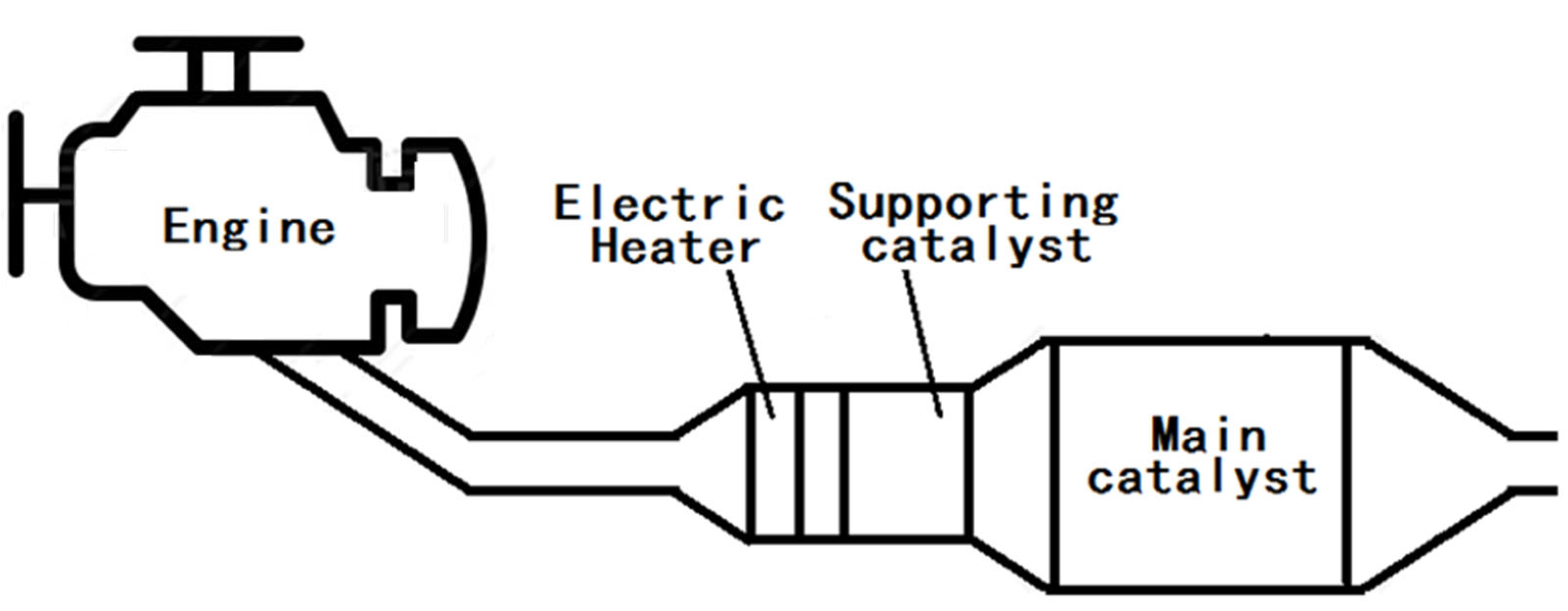

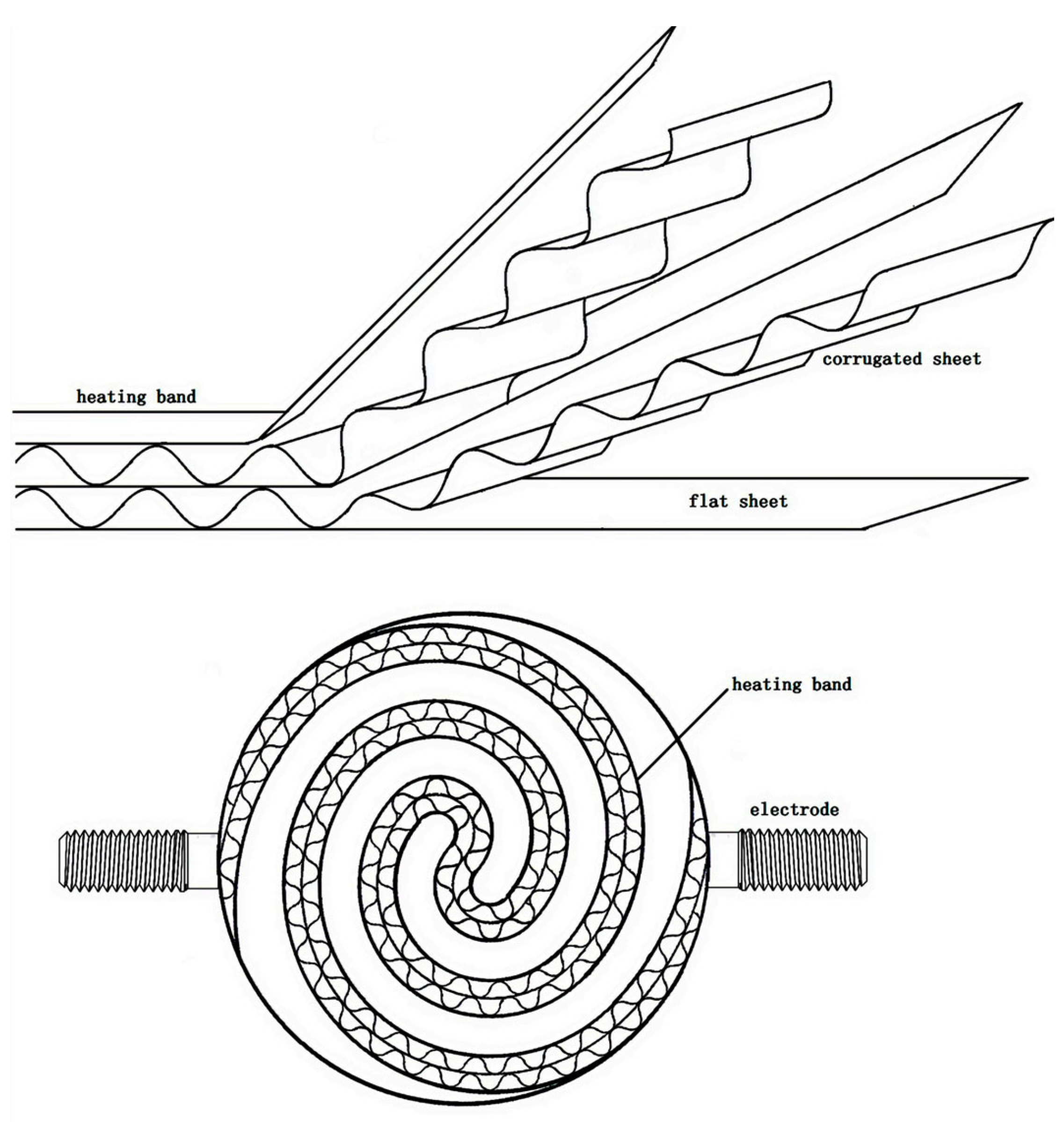
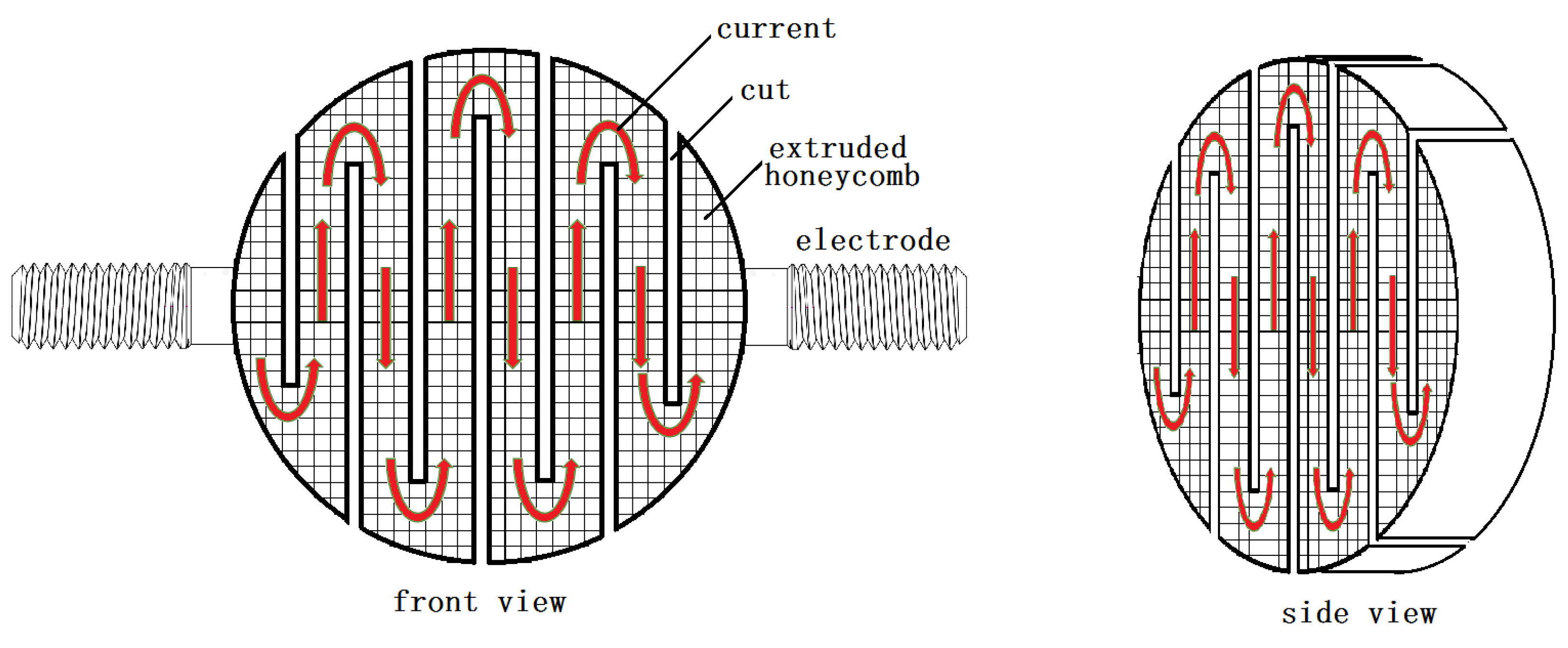
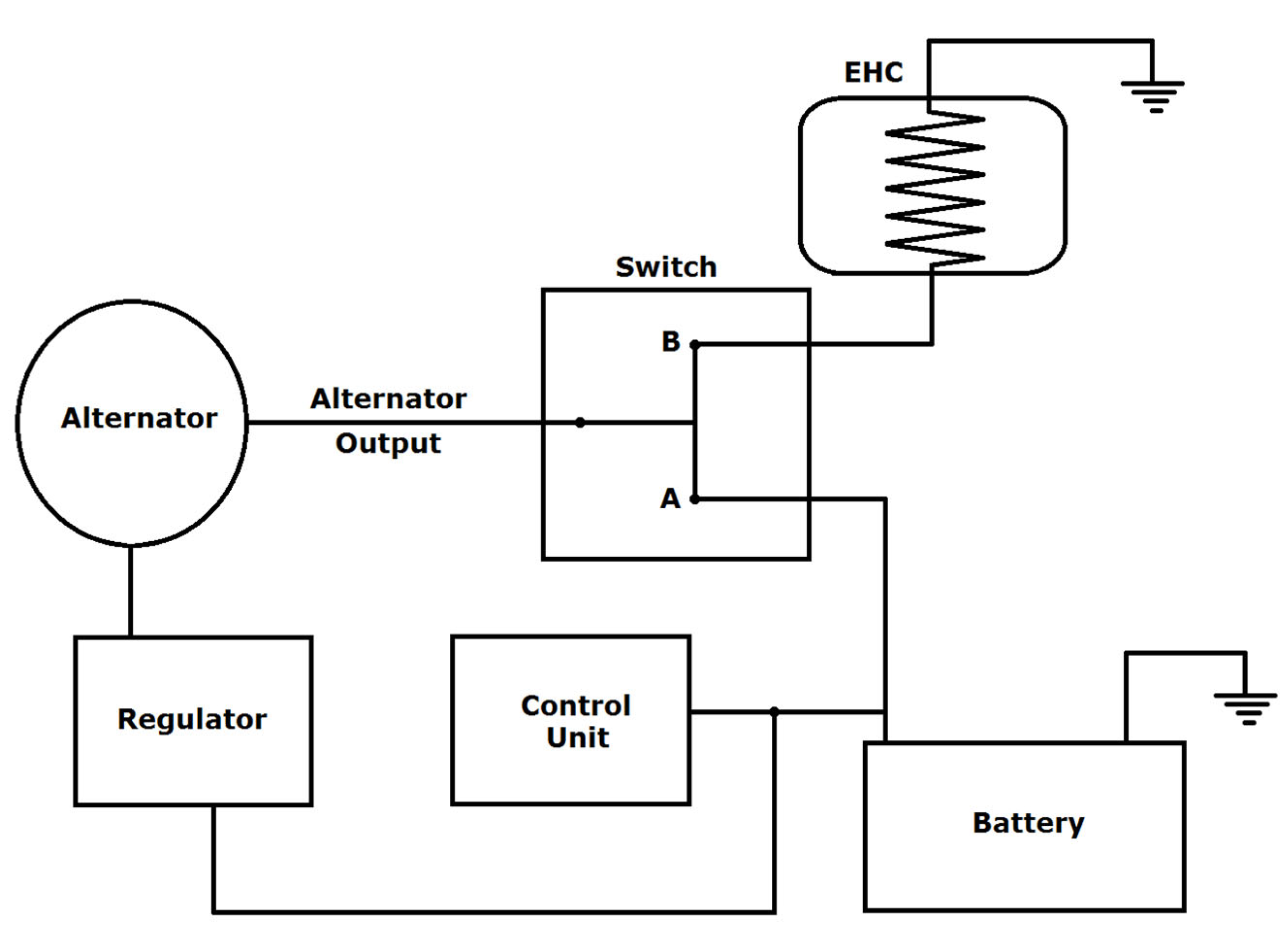
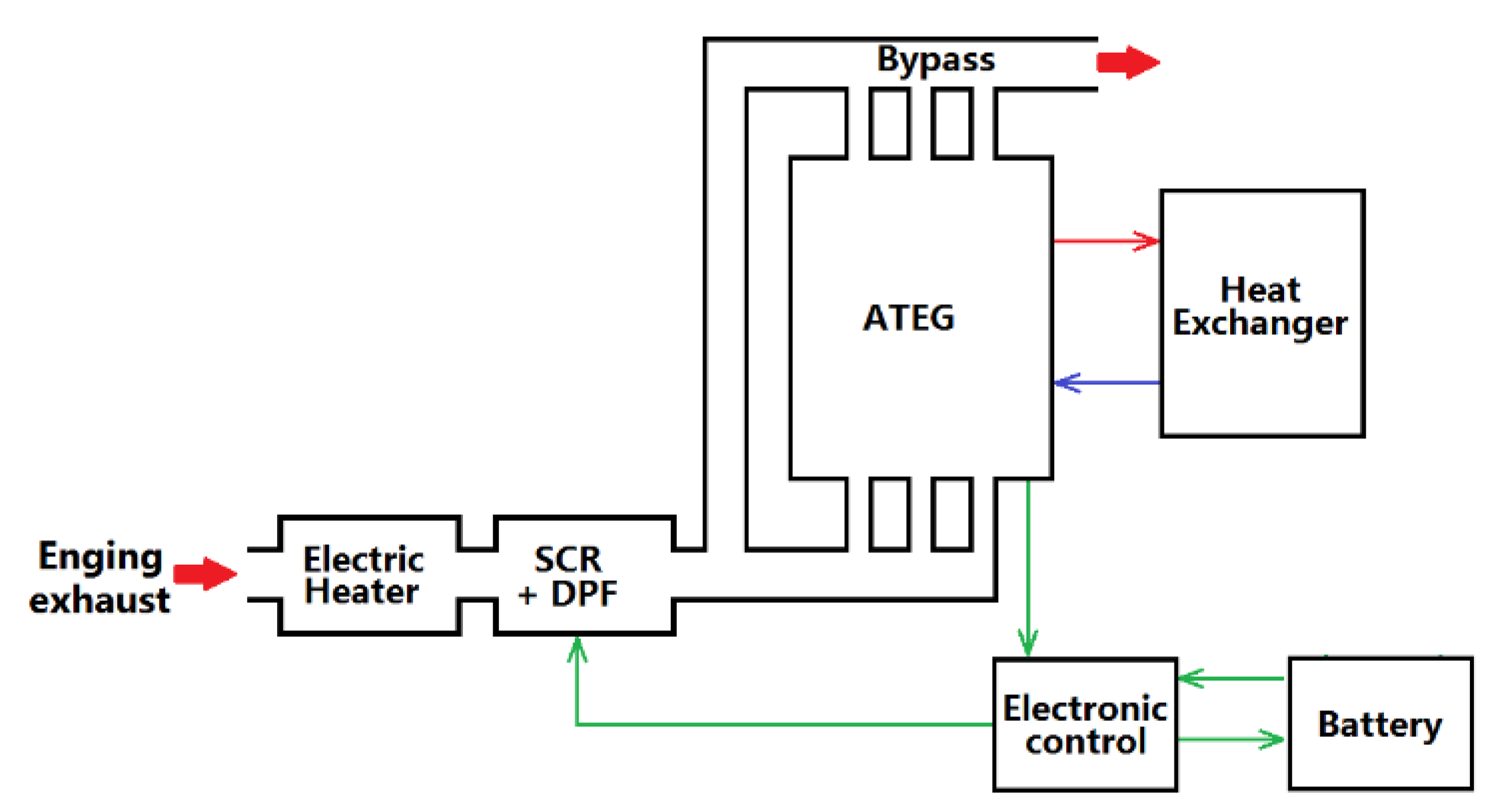
Disclaimer/Publisher’s Note: The statements, opinions and data contained in all publications are solely those of the individual author(s) and contributor(s) and not of MDPI and/or the editor(s). MDPI and/or the editor(s) disclaim responsibility for any injury to people or property resulting from any ideas, methods, instructions or products referred to in the content. |
© 2024 by the authors. Licensee MDPI, Basel, Switzerland. This article is an open access article distributed under the terms and conditions of the Creative Commons Attribution (CC BY) license (https://creativecommons.org/licenses/by/4.0/).
Share and Cite
Li, K.; Xiao, B.; Wang, Y.; Jia, J.; Wu, X. Applications of Electric Heating Technology in Vehicle Exhaust Pollution Control. Processes 2024, 12, 298. https://doi.org/10.3390/pr12020298
Li K, Xiao B, Wang Y, Jia J, Wu X. Applications of Electric Heating Technology in Vehicle Exhaust Pollution Control. Processes. 2024; 12(2):298. https://doi.org/10.3390/pr12020298
Chicago/Turabian StyleLi, Kai, Bing Xiao, Yanjun Wang, Jianli Jia, and Xiaodong Wu. 2024. "Applications of Electric Heating Technology in Vehicle Exhaust Pollution Control" Processes 12, no. 2: 298. https://doi.org/10.3390/pr12020298




